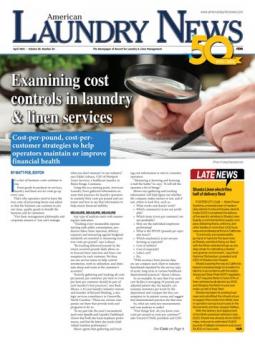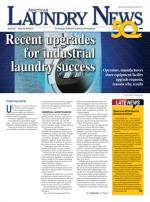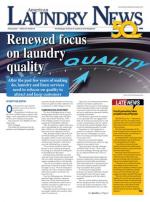Cost Control in Motion for Laundry/Linen Delivery

FORT LAUDERDALE, Fla. — While inflation has been kept in check for much of the broader economy over the last few months and diesel prices have declined, the cost of diesel fuel may have negative ripple effects across the economy, particularly for cleaning distribution fleets.
Demand for domestic transportation of goods is expected to increase in the coming months as cleaning companies cut much of their excess inventory over the last few years and have focused on reshipping and restocking, along with construction projects spurred by President Joe Biden’s stimulus plan that increases the use of diesel trucks.
This means diesel consumption will increase at a time when prices have crept back up and geopolitical tension has placed a further strain on diesel supplies.
The national on-highway average for trucking’s diesel fuel was $4.146 per gallon as of Nov. 27, according to the U.S. Energy Information Administration.
While prices have fallen slightly, a colder-than-normal winter has placed even more pressure on supplies of diesel, making prices more difficult for cleaning distribution fleets to absorb.
The trend is likely to place even more pressure on cleaning distribution fleets operating on razor-thin margins at a time when overall costs are rising and they’re looking at every way possible to keep bottom lines healthy.
According to ATRI’s (American Transportation Research Institute) recent report, the cost of operating a truck in 2022 was $2.251 per mile, surpassing $2 per mile for the first time in the history of ATRI’s studies.
Sure, a lot of this increase was due to high fuel costs, but other cost centers saw jumps by double-digit percentages as well, including repair and maintenance, truck and trailer lease or purchase costs due to the increase in equipment costs, and driver wages, according to ATRI’s analysis of the operational costs of trucking 2023 update.
The report also indicates that the cost of trucking, with fuel included, increased by 21.3% in 2022 compared to the previous year. Truck and trailer payments, repair and maintenance, auto liability insurance premiums, tires, and driver wages all set record-high marginal costs in 2022 (National Private Truck Council [NPTC] Benchmarking Report).
On the private fleets side, the overall cost of trucking was listed as the third most prominent challenge in this year’s NPTC 2023 Benchmarking Report, compared with the fourth overall challenge the previous year.
All of this means cleaning companies are now leveraging better data and analytics to pay closer attention to their truck replacement opportunities.
Gone are the days of basing replacement decisions off experience-driven guestimates—today’s industry is centered on data technology driven by asset management firms that provide a holistic view to scrutinize how every individual spec impacts utilization and the bottom line.
As evidence of this, the December 2023 Truck Life Cycle Data Index (TLDI), calculating the cost savings associated with replacing older-model units with the latest truck equipment, shows that fleets can realize a first-year per-truck savings of $15,347 when upgrading from a 2019 model year daycab truck to a 2024 model, according to the Fleet Advantage Truck Life Cycle Data Index, December 2023.
Across a fleet of 100 class-8 trucks, this equates to $1,534,700. This also represents a 12% decrease in emissions.
Parts and labor cost data recently showed that significant cost challenges continue to impact cleaning distribution fleets. According to data from American Trucking Associations’ Technology & Maintenance Council, on a year-over-year basis between the fourth quarter of 2022 and Q4 2021, parts and labor costs rose by 14.4% and 10.8%, respectively, and combined expenses were up 13%.
Earlier in 2022, annual comparisons between quarters showed that combined parts and labor costs were up 15.3%, parts costs rose 15.8%, and labor expenses increased by 14.6%, (FleetOwner.com, “Maintenance and repair costs rise, but rate of increase slows,” March 2, 2023).
One way cleaning distribution fleets are overcoming these cost challenges, especially for maintenance and bottom-line economic trends, is by leveraging predictive modeling.
Predictive data leverages science and analytical trends to create algorithms and formulas that combine economic insights along with data mining trends to arrive at a forecasted output that is scrutinized for more accurate fleet planning.
When making critical business decisions, predictive modeling can be extremely beneficial in cleaning distribution fleet executives’ leverage of past and present data. These cleaning companies have relied on data to leverage key insights to help determine a company’s “tipping point,” the point at which it makes more financial sense to replace an aging truck in the fleet with a newer, more efficient and safer model.
However, today, tech-savvy cleaning companies are using predictive modeling to help forecast this tipping point by looking into the future and selecting specific dates to gain visibility into the future life cycle performance and replacement economics of each truck.
Fleets can analyze any number of criteria, including truck make, model and type, as well as utilization characteristics such as usage location and fuel metrics.
This critical insight helps predict the savings over the next one, two or three years and shows where unit replacements would present operational cost savings over the predicted time allotment during that time span.
With this data analytics technology in hand, cleaning distribution fleet executives can work with their asset management partners to identify where long-term cost savings can be found in the investment of newer trucks with safer technologies, even though the cost of equipment has increased on the front end.
And with safety features more readily available on today’s new trucks, additional cost savings in accident avoidance and insurance can also be realized.
Lastly, with environmental regulations on the minds of many cleaning distribution fleet executives, many are wondering when it makes the most sense to bridge over to alternate fuel technologies like electric vehicles.
This bridge is different for every company, and data technology and analytic tools are now being utilized to help cleaning distribution fleets take into consideration various inputs including equipment cost, charging, cost of energy, cost of diesel, grants, tires, depreciation, etc., and converts them into a cost per mile (CPM) to determine the total cost of operating an electric vehicle over its lifetime, allowing cleaning distribution fleets to make an informed decision about which type of vehicle is more cost-effective for their fleet.
In many cases, the data shows that diesel trucks are more cost-effective for their operations, but now they have the data tools available to make the right comparison.
With the availability of the right data analytics, as well as strategic input from asset management partners, cleaning distribution fleets are best equipped to make the right decisions to offset operational and diesel costs no matter the fluctuating price of fuel.

Cultivating Trust in Laundry Teams (Conclusion)

Cultivating Trust in Laundry Teams (Part 1)

Record-Breaking Attendance at ALM’s 2024 IMPACT Conference

Dialing in Chemical Representative/Laundry Relationships (Conclusion)

Xos Accelerates Growth with Acquisition of ElectraMeccanica

Dialing in Chemical Representative/Laundry Relationships (Part 1)

Cintas Named One of Forbes’ America’s Best Large Employers

Improvements are Constant in the Laundry Game

Solenis Earns Distinction for Corporate Social Responsibility

WW Services—History of Facility Services, Uniform Solutions
Podcasts for You
Disaster Preparedness for Laundries

At some point, a laundry is going to face a disaster, at least losing power. In this episode, guest Bob Corfield, principal of Laundry Design Group, talks about ways to keep goods moving during these challenging times.
Reducing Rewash

In this episode, Gregory Gicewicz, president and CEO of Sterile Surgical Systems in Tumwater, Washington, talks about the common causes of rewash and ways laundry/linen services can eliminate rewash as much as possible.
We’re Heading for Recession! Now What Do I Do?

Bryan Cutsinger, assistant professor of economics at Angelo State University in Texas, and Mike Knowles, COO of Superior Linen Service in Oklahoma, talk the economy, the possibility of recession and ways to ride out the downturn.
From the Research Center
Laundry Design & Construction: Creating the Ideal Workflow

Laundry Chemicals & Dispensing: Finding the Right Chemistry

Cheap Ways to Corral Laundry Costs: Cost Control for Textile Services

Latest Digital Editions
Digital EditionAmerican Laundry NewsApril 2024

- Examining Cost Controls in Laundry & Linen Services
- Improvements are Constant in the Laundry Game
- Dialing in Chemical Representative/Laundry Relationships
- Cultivating Trust in Laundry Teams

